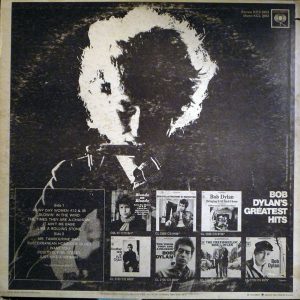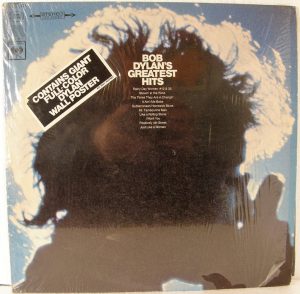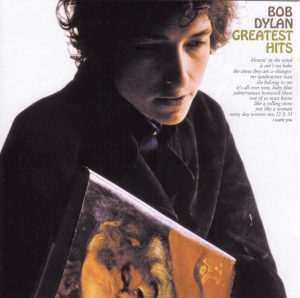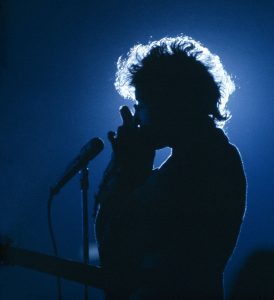by Patrick Roefflaer
A compilation album isn’t actually part of this series concerning the artwork of the sleeves of Dylan’s studio albums, but the history of his first greatest hits album is too beautiful not to mention. Especially since, in 1966-67, three albums appeared with that same title.
The Netherlands: Bob Dylan’s Greatest Hits – No One Sings Dylan Like Dylan
- Released: March 27, 1966
- Photography: Jerry Schatzberg
- Art-director: ?
Worldwide, CBS Holland was the first to release a compilation of Bob Dylan’s songs – exactly one year before the Columbia Records did the same in the US. Up until then only three mono albums of the singer had officially been released in the Netherlands.
The title, Bob Dylan’s Greatest Hits, wasn’t exactly right, as ‘Positively Fourth Street’ was missing and four songs were previously unreleased in Holland and Belgium and so completely unknown to the listeners. Because this compilation appeared before Blonde on Blonde was released, there’s nothing from that double album between the 12 selected songs.
On the front, there’s a picture made by Jerry Schatzberg, during a session for Blonde on Blonde. During that session, on January 28, 1966, Dylan fooled around with random object that were present in the photo studio. A picture was chosen of Dylan with a cigarette in one hand and an ridiculously large Zippo lighter in the other.
On the sleeve, a subtitle is visible in the upper left corner: ‘No One Sings Dylan Like Dylan’. A slogan first used by CBS UK on June 21, 1965, to promote Bringing It All Back Home.
Great-Britain: Bob Dylan – Greatest Hits
- Released: December 1966
- Photography: Jerry Schatzberg
- Art-director: ?
Some nine months later, CBS UK released a similar album in Great-Britain and Ireland, titled Greatest Hits. Like the Dutch compilation it contains 12 songs, but since Blonde on Blonde was a hit by then, there’s a different selection of songs.
Many people seem to think that this album first appeared in 1967, even suggesting it was released at the same time as the US version. However the album entered the British sales list on January 14, 1967, so a release date somewhere in the last weeks of 1966 is more probable.
More important for our story is that this British album has a different sleeve design. Like the Dutch release, this photo is chosen from the same session with Jerry Schatzberg (January 28, 1966).
On the front there’s a picture of Bob Dylan, deep in thoughts, before a white background and in his arms is a large book with a portrait of a Biblical looking man.
The bearded man is a fragment from De aanbidding der wijzen (The Worship of the Kings), a painting by Peter Paul Rubens from 1624. The book by Jacques Lassaigne, published in New York in 1958, is titled Flemish Painting from Bosch to Rubens.
There are other pictures from that sessions from Dylan with the book, which make it obvious that the picture is mirrored for the sleeve. That way there’s room for the record company’s logo on the left and titles of the album and the songs on the right.
On the back of the sleeve the song titles are printed once more, plus the pictures of six of the seven regular Dylan albums appeared until then – for some reason Another Side of Bob Dylan is missing.
US: Bob Dylan’s Greatest Hits
- Released: March 27, 1966
- Photography: Rowland Scherman (front), David Gartner and Fred Hammerstein (back)
- Poster: Milton Glaser
- Art-director: John Berg
In early July 1966, while riding his Triumph motorbike, Dylan had an accident. After this, he disappeared completely from the public eye. As there was no communication at all from the Dylan camp, a lot of speculation was raised: the singer had broken his neck or he might even be dead. Others pretended to know he was in rehab.
Whatever the facts: Bob Dylan had a perfect excuse to cop out. His manager, Albert Grossman canceled all his obligations: the rest of the tour, plans for a book, a play and a movie. Even the deal to deliver one last album to the record company was renegotiated, so that he didn’t have to go into the record studio any more.
The staff at Columbia Records felt the chapter Bob Dylan came to an end and proposed a compilation album. The time was ripe as recently at least one big name had released a greatest hits for the first time: The Rolling Stones (Big Hits (High Tide and Green Grass) – March 1966), while others would do so soon: The Beach Boys (Best of the Beach Boys – July 1966) and The Beatles (A Collection of Beatles Oldies – December 1966).
Dylan himself however didn’t like the idea and refused to co-operate. He didn’t even want attend a photo session for the sleeve.
So the art-director had to be creative.
“Dylan had no direct input in it,’ explained photographer Rowland Scherman in 2013 to Ben Yakas. ‘It was in his contract that he could veto any picture he didn’t like. But this was actually in between contracts. He got another contract a month or so later [actually August 21 1967], but in between contracts he didn’t have the chops to change it.”
Front
The remarkable picture on the front is made by Rowland Scherman, then a freelance photographer mainly working for Life magazine.
The photo was made on November 28, 1965. On that day Dylan played the Coliseum in Washington DC. Scherman lived nearby and visited the concert with his wife. A good photographer always carries his camera and Rowland used his press card to get backstage.
In the book Encounters with Bob Dylan (Tracy Johnson – Humble Press, 2000) Scherman explained: “Dylan was in that dirty blue spot, doing some song I can no longer remember. I put the 300 mill on him, and I could see the whole thing. His hair, his halo, his harp — the three H’s. So, I went bang, bang, bang, bang — six or seven frames. No motor or anything. Then, I said, ‘Thank you very much, I’ll be leaving now.’ I didn’t hang around. I just kept thinking, ‘It doesn’t get any better than this,’ and went back to watch the rest of the concert.”
Sometime later Scherman showed the pictures to the fiancé of his sister, who happens to be the art director at Columbia: “I took them up to John Berg – he’d done dozens of album covers, and he looked through this stack, which was only about an inch-thick stack of slides, and the third one he picks up, he said, ‘That’s the next cover.’ It happened faster than I just told you about it.”
Berg offered him to buy the photo. “I got paid three hundred bucks for shooting that album cover. Three hundred bucks. In 1966, that wasn’t bad dough, it was a couple of months’ rent.”
“John Berg, smart as he was, blew it up big and cropped it real tight and flopped it so his face was looking the other way, and then wrote the type in the top of his head. It was my idea to shoot it backlit, and this may be the first backlit album anywhere. But it was his design that really made it as strong as it was.”
Back
On the backside of the sleeve, there’s a picture of a similar backlighted Bob Dylan.
There’s not much info to be found on this photo. To make the mystery even greater: there are two people credited: David Gartner and Fred Hammerstein.
 At that time, Gartner was the official photographer of Playboy magazine and was specialized in making pictures of the bunny’s and all kinds of famous people at party’s.
At that time, Gartner was the official photographer of Playboy magazine and was specialized in making pictures of the bunny’s and all kinds of famous people at party’s.
In my search for info, I found David Gartner on Facebook. Much to my delight, he was prepared to answer my questions. “That photo was taken in Queens New York at Forrest hills tennis courts, now called Arthur Ashe Stadium. I was photographer and Fred Hammerstein. 1968.”
I suggested that it might have been Forest Hills Tennis Stadium in New York. On Augustus 28, 1965 Bob Dylan played there, for 15.000 people, the openings concert of his very first tour with a band.
Mister Gartner confirmed date and location, and added: “I do remember that the photo was taken behind the curtain. As he turned his head to the curtain and the floodl ight hit behind him to lighten up his hair.”
ight hit behind him to lighten up his hair.”
About why there are two names mentioned, Mister Gartner explained: “It was my assignment to photograph Bob Dylan, [for the promoter for the concert, Jerry Weintraub]. As Fred Hammerstein was working with me I thought it would be fair to put both names down.”
So, as this picture was taken three months before Scherman made the picture used on the front of the sleeve, it’s possible that John Berg already had Gartner’s photo, recognized the similarity between the two images and worked from there.
Poster
Another stroke of genius from Berg was to add a third image of Dylan without facial features: a large poster, put inside the sleeve.
Again the design was pre-existing: Push Pin Studios had printed the poster in 1966 – but it isn’t clear if it was actually sold. The poster was designed by one of the founding members of the studio: Milton Glaser.
Milton Glaser was a graphic designer (in 1976 he made the I♥NY logo for the city of New York), and coincidently he happened to be a friend of Dylan’s manager Albert Grossman. As such, Grossman had asked him to design the cover of Dylan’s book: Tarantula.
Glaser was inspired by a work of the French artist Marcel Duchamp: Self Portrait in Profile, from 1959. Just like Duchamp he drew Dylan’s profile as a black silhouette, simply placed against a plain white background. This places the focus on the huge colorful swirls which represent Dylan’s free flowing long hair. Long hair, that at this point in history was a symbol of freedom and non-conformity and would have had an obvious appeal to fans of his music.
non-conformity and would have had an obvious appeal to fans of his music.
Because the book was on hold, and it would be a shame to waste such a beautiful image, plans were made to sell it as a poster.
John Berg asked Glaser for few minor changes: the original hair was in brown and blue, so Berg asked for more color. Also, a suggestion of Glaser to add an harmonica in a holder, was found superfluous by Berg.
Grammy
The photo by Scherman and the design by John Berg (and his superior Bob Cato) win a Grammy for best album cover in 1968. “The Grammy shows up,” says Scherman, “and my name’s misspelled, just like it is on the album. Not only that, but the gramophone part was broken. I packed it back up and said, ‘Thanks a lot, but spell my name right and send me another Grammy.’ Never heard from them again. What knocks me out now is that he’s turned out to be one of the icons of the ’60s. That makes me proud, along with the fact that it’s in the Library of Congress.”




1. Typo: US Bob Dylan’s Greatest Hits released March 27, 1967 not 1966
2. Further investigation (see following link) has learned the Dutch version was also released in 1967, not 1966. It was based on a German “Stern” release which was released in the summer of 1966 (with the same Zippo cover) making that one the first Dylan compilation album.
http://bobdylaninnederland.blogspot.com/2019/11/bob-dylans-greatest-hits.html
I had all of the three greatest hits albums years ago.
My favorite was the UK version
Nice article here
My sister and Berg were not engaged, just pals. Also, I didn’t have a press pass to get backstage—I just did it. I had to.
Rowland thank you for correcting the information – and indeed thank you for reading.
Dylan is a gift to us all. Now, at this advanced age, to have him do one more collection of songs is pretty amazing to me. I met him at the Indian Neck Folk Festival before the first album. He was playing harmonica and hanging with Kweskin and other Jug Band folks (Maria and Geoff, and Fritz and Bill Keith) and some others from Boston. I had a car a drove a bunch of us back to Boston and Dylan showed up at Club 47 and did Talking Bear Mountain Picnic Massacre Blues and just blew the place up. We had never heard a talking blues anything like that…people at that time were just exploring Woody’s talking blues and no one had any inkling that this kid could do this kind of music. Well, that was then and now is now and he’s still amazing us with his genius.
We have an original Kodalith of the photo taken by Fred Hammerstein. We were close with Fred, who died in the 1990’s and his wife Akemi, who is now living in Japan. Both insisted that it was Fred who took the photo. For us it is a reminder of our friends and has great sentimental value because Fred had to fight for that recognition more than the fact that it’s an iconic photo. I think Dylan would appreciate that. The Kodalith currently resides in Mexico.
Thanks for the information Abigail. I appreciate it.
Mr. Tony Attwood,This was MY photo assignment given to me by the promoter, Jerry Weintraub, (Bob Dylan’s Greatest Hits album). This was MY picture taken by me at Forest Hills Stadium. Fred Hammerstein worked for me and helped develop pictures that I took in MY studio on E. 46th and 6th Avenue in Manhattan. This photo by ME was given to Sony Music/Legacy Recordings (Columbia Records) and I always kept an eye that the correct credit was given. The letter below is from the record company that I worked with.Thank you,David Gartner
Mr. Tony Attwood,This was MY photo assignment given to me by the promoter, Jerry Weintraub, (Bob Dylan’s Greatest Hits album). This was MY picture taken by me at Forest Hills Stadium. Fred Hammerstein worked for me and helped develop pictures that I took in MY studio on E. 46th and 6th Avenue in Manhattan. This photo by ME was given to Sony Music/Legacy Recordings (Columbia Records) and I always kept an eye that the correct credit was given.
Thank you
David Gartner
PS If you’d like to see the letter that the record company had sent to me, please send me your email. By the way, it was Sony Legacy (Columbia Records) that bought it.
Mr. Attwood,
Upon review what I had written, I would like to correct the wording that Fred Hammerstein worked with me instead of for me. Fred Hammerstein was a very talented man. We worked on many projects together. I’m sorry to hear about his passing.
I need to make things clear. Mr. Hammerstein worked with me and for me. I brought in all the business when we worked together. Mr. Hammerstein and I also worked in a lighting system we both put together. At all times I put ALL the money in to buy equipment to put our lighting system together. The equipment used was very expensive to buy (very expensive rubber SCREENS and equipment).I found out recently that all the money I put in with our joint partnership in a lighting company that Mr. Hammerstein and I owned, there was business being done without my knowledge with another person. All this now seems familiar? What other things happened without my knowledge?Most important of everything, whatever we had that we put together, I was the only one with the contacts for the business and people we dealt with to make it happen. Mr. Hammerstein, as far as I remember, for years Mr. Hammerstein had not brought in one job but did work with me on the jobs that I brought in. If the other person who wrote the article knew that there ever has been ONE TIME that Mr. Hammerstein brought in one job that we worked together with any of his contacts, please let me know.I took Mr. Hammerstein with me when I photographed Bob Dylan. He also photographed there. Mr. Hammerstein and/or I developed the negatives in my studio. Mr Hammerstein was also credited as he was with me at Forest Hills Stadium. When many photographers get an assignment, it is their assignment. Not many photographers give credit to others. 1) The Bob Dylan job was given to me through Jerry Weintrub (he can be googled), an American film producer, talent manager and actor whose television films won him three Emmys.The lighting assignment Mr. Hammerstein & I worked on was used on Mike Douglas TV show, Merv Griffin show and all of this was done only with my contacts only. We did the Johnny Carson show using our lighting with Richard Harris as we did MacArthur Park, a seven minute number on the show. The producer of the tonight show, Stu Irwin the Executive producer, wanted to go partners with us on the lights. We then did a New Year’s show at Woody Allen’s house on 79th Street for New Year’s Eve using the lights. Mr. Hammerstein and I also did a lighting show with me for CBS called “Spoon River Anthology” with Jason Robards.We also did a record album for the entertainment Director Kai Winding from Playboy New York Penny Lane. ( I have the photo if you would like to see it as it WAS photographed in my studio including the lighting that is on the cover of the album). I have won Proclamations in years ago. the past and had someone work with me. I made the contact add the person that was with me. I had to fight to add his name to the proclamation. I tried to have something for him to use in the future. This is the FIRST time I ever heard there was a misunderstanding about Credits. You would think that would have been brought up 50 years ago.
Here is another photo album that I photographed, Fred Hammerstein and I created the lighting system. I again put photo credits David Gartner and Fred Hammerstein as Fred didn’t photograph the cover. I always was fair and put the other persons name on albums and Proclamations. Open attachment below See credits
https://music.metason.net/artistinfo?name=Kai%20Winding&title=Penny%20Lane%20%26%20Time
Thanks for finwlly talking about > The untold story
of the artwork on Bob Dylan’s Greatest Hits – Untold Dylan burç yorumları